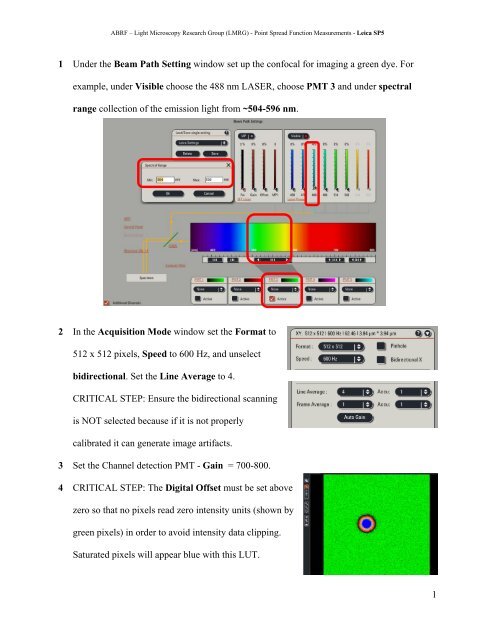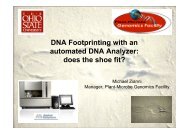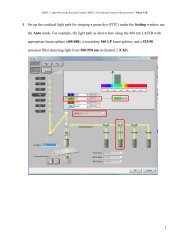Point Spread Function Protocol Leica SP5
Point Spread Function Protocol Leica SP5
Point Spread Function Protocol Leica SP5
Create successful ePaper yourself
Turn your PDF publications into a flip-book with our unique Google optimized e-Paper software.
ABRF – Light Microscopy Research Group (LMRG) - <strong>Point</strong> <strong>Spread</strong> <strong>Function</strong> Measurements - <strong>Leica</strong> <strong>SP5</strong><br />
1 Under the Beam Path Setting window set up the confocal for imaging a green dye. For<br />
example, under Visible choose the 488 nm LASER, choose PMT 3 and under spectral<br />
range collection of the emission light from ~504-596 nm.<br />
2 In the Acquisition Mode window set the Format to<br />
512 x 512 pixels, Speed to 600 Hz, and unselect<br />
bidirectional. Set the Line Average to 4.<br />
CRITICAL STEP: Ensure the bidirectional scanning<br />
is NOT selected because if it is not properly<br />
calibrated it can generate image artifacts.<br />
3 Set the Channel detection PMT - Gain = 700-800.<br />
4 CRITICAL STEP: The Digital Offset must be set above<br />
zero so that no pixels read zero intensity units (shown by<br />
green pixels) in order to avoid intensity data clipping.<br />
Saturated pixels will appear blue with this LUT.<br />
1
ABRF – Light Microscopy Research Group (LMRG) - <strong>Point</strong> <strong>Spread</strong> <strong>Function</strong> Measurements - <strong>Leica</strong> <strong>SP5</strong><br />
5 Choose the 488 nm LASER line and set the LASER power to ~0.5% (~8 µW). If the LASER<br />
power is set too high then pixels will saturate (shown as blue pixels above) and high intensity<br />
data clipping will result in non-quantitative data.<br />
6 Set the Pinhole to 1 Airy unit and take an image of the microspheres.<br />
7 Under the Acquisition tab check zoom in, then on the image pane draw a rectangle around<br />
one microsphere. This will result in image acquisition of only the region containing the<br />
microspheres. CRITICAL STEP: Verify that the Pixel Size is at Nyquist sampling, if not use<br />
the zoom factor to adjust. See details in the main paper.<br />
2
ABRF – Light Microscopy Research Group (LMRG) - <strong>Point</strong> <strong>Spread</strong> <strong>Function</strong> Measurements - <strong>Leica</strong> <strong>SP5</strong><br />
8 Verify the image acquisition settings using the Range Indicator Look Up Table<br />
(LUT). Zero intensity pixels are green and saturated pixels are blue. For ideal<br />
acquisition settings you should have no green or blue pixels. If there are green<br />
pixels increase the Digital Offset, if there are blue pixels reduce the LASER<br />
power or PMT gain.<br />
9 See the main protocol paper for details on how to set the Z-image spacing.<br />
10 Choose the XZY Acquisition mode and set up the y-axis scanning. Drag the white line to<br />
the center of the bead. Enter in the Nr. of steps and the y-step size to ensure you capture the<br />
entire PSF image at the appropriate resolution. The Set Plane button can also be used to set<br />
the first and last planes in the stack.<br />
11 Collect the stack of images and save the file in both TIFF and <strong>Leica</strong> file formats.<br />
3
ABRF – Light Microscopy Research Group (LMRG) - <strong>Point</strong> <strong>Spread</strong> <strong>Function</strong> Measurements - <strong>Leica</strong> <strong>SP5</strong><br />
12 Save all your files with your name and the name of the instrument you collected the data<br />
on. Send the following information to the ABRF-LMRG at abrf.lmrg@gmail.com:<br />
a) Summary of the measured resolution in X,Y,Z for at least 5 microspheres measured<br />
with the pinhole set to 1 Airy Unit.<br />
b) One representative MetroloJ report for data collected with the pinhole set to 1 Airy<br />
Unit.<br />
c) Summary of the measured resolution in X,Y,Z for at least 5 microspheres measured<br />
with the pinhole set to 5 Airy Units.<br />
d) One representative MetroloJ report for data collected with the pinhole set to 5 Airy<br />
Units.<br />
4





